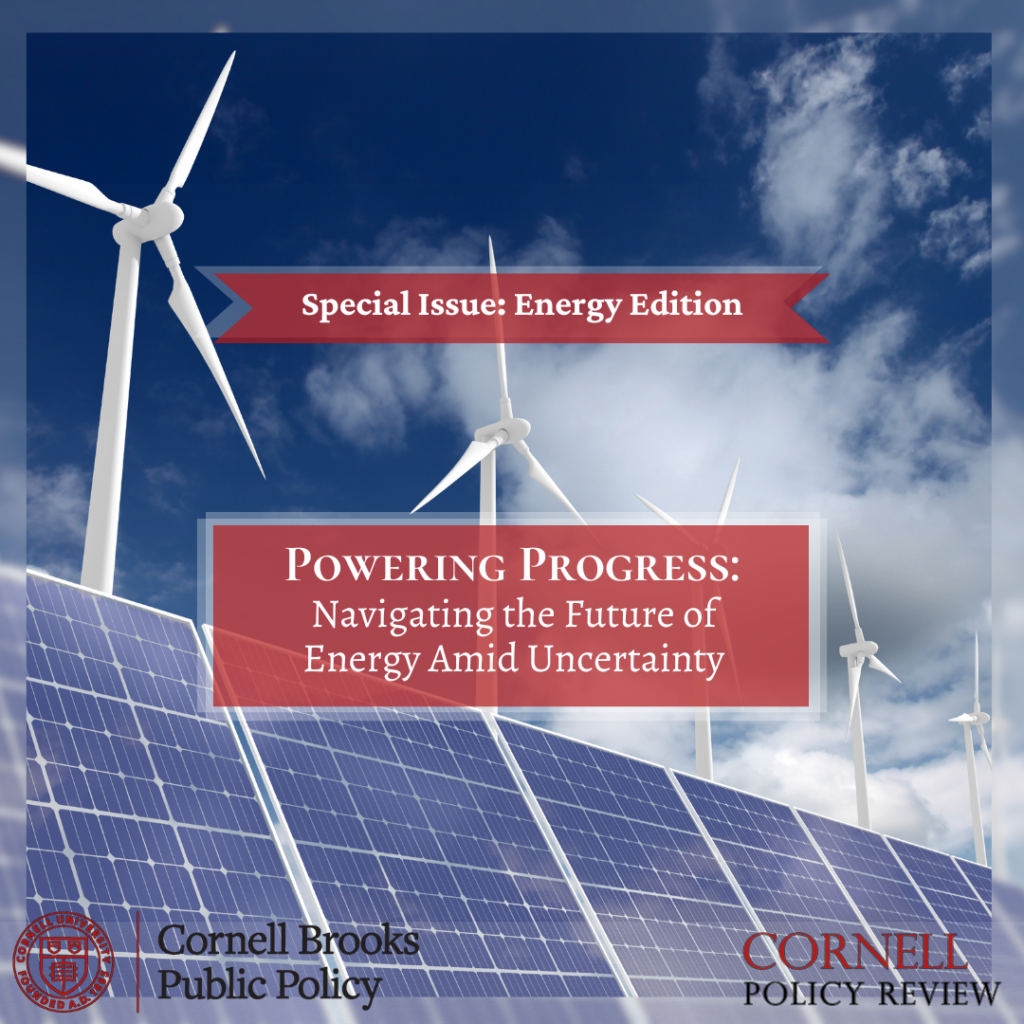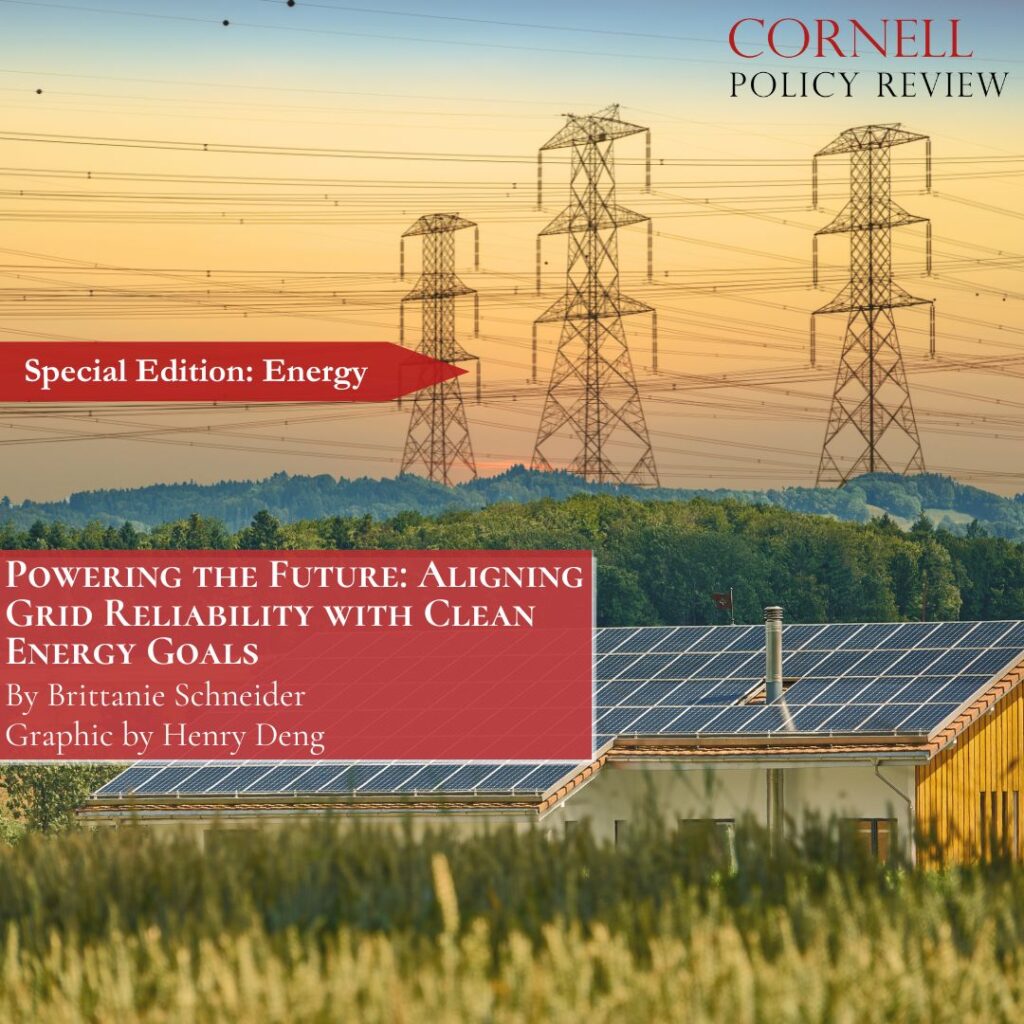By: Ojasvi Rana
Edited By: Ava LaGressa
The global push for net-zero emissions by 2050 faces a harsh reality: fossil fuel production is unlikely to reach a peak (and eventually decline) in the foreseeable future. Global energy demands are surging, driven by energy-intensive emerging technologies, increased economic activity and the growing impact of extreme weather.1 While renewables like solar hold promise, their inability to ensure 24/7 grid reliability makes them ill-equipped to meet immediate energy needs. As such, investing heavily in renewables risks becoming a significant misallocation of resources. Nuclear energy stands out as the only viable short-term solution capable of balancing the demands of net-zero goals with current energy requirements. Transitioning to a renewable-dominated grid is a long-term endeavor, and prioritizing investment in renewables over nuclear and cleaner fossil fuel technologies may inadvertently increase reliance on fossil fuels, as renewables struggle to address immediate energy demands.
Global electricity demand is projected to grow at an average annual rate of 3.4% through 2026, with about 85% of this increase driven by emerging economies in Asia, including China and India.2 Meanwhile, energy consumption from data centres, artificial intelligence (AI), and the cryptocurrency sector could double by 2026, adding further strain to electricity systems.3 The first half of 2024 highlighted the challenges ahead, as intense heat waves spiked air-conditioning usage and pushed grid systems to their limits. A reliable electricity system operates seamlessly under normal “blue sky” conditions, while a resilient system withstands extreme “grey sky” climate events.
Renewable electricity sources are set to expand rapidly, with their share of global electricity supply projected to rise from 30% in 2023 to 35% by 2025.4 Solar photovoltaic (PV) energy and wind combined are expected to meet as much as three-quarters of the growth in global electricity demand over 2024 and 2025.5 The U.S. grid requires significant expansion and modernization to be able to handle the increase in clean energy production. Current infrastructure struggles with interconnection capacity and regulatory hurdles, slowing the integration of renewables and storage solutions. While clean energy will be rapidly produced thanks to various production subsidies such as tax credits and Inflation Reduction Act (IRA) incentives, the question is, where will all the extra energy go?6 A short-term grid management solution is presented by Australia, which is introducing a “sun tax” on households and businesses who export solar energy to the grid during peak hours when the network is congested.7 The goal is to balance supply and demand, stabilize the energy system, and avoid costly network upgrades. In the long term, however, extensive network upgrades will be essential, yet a US$14.3 trillion shortfall in global grid investment is expected by 2050, and the development timeline for grid infrastructure is three to seven times slower than that of renewable energy installations.8 Without accelerated grid investments, the clean energy boom risks being stymied by infrastructure bottlenecks.
Excess solar energy production poses a problem for grid infrastructure and to “grey sky” reliability. The output from solar farms drops by 75% to 90% when clouds cover the sun.9 The intermittency of solar and wind energy highlights a critical limitation: they cannot replace 24-hour dispatchable baseload power sources like coal or gas plants without significant advancements in storage and grid infrastructure. This challenge is already evident in early adopters of intermittent renewables, such as California, Texas, and Germany, where grid instability and blackouts have highlighted the risks of transitioning too quickly without sufficient backup systems. California, for instance, has delayed the shutdown of the Diablo Canyon nuclear plant, maintained gas plants, and scaled back new residential solar installations to address reliability concerns.10, 11, 12 Germany, after phasing out nuclear and fossil fuel power and relying too heavily on intermittent wind and solar power, has faced sole dependence on Russia’s supply of natural gas, exposing vulnerabilities during geopolitical crises like the Russia-Ukraine war which drove up energy costs.13 Texas, with its reliance on wind power, experienced catastrophic grid failures during the 2021 winter storm when freezing conditions disrupted both natural gas and renewable energy systems. The state’s isolated grid, lacking interconnections with neighboring regions, compounded the crisis by preventing power imports during shortages.14 These cases highlight the critical need for balancing renewable adoption with robust grid modernization, energy storage, and a diversified energy mix.
A practical solution lies in the implementation of self-sufficient microgrids—energy systems that combine two or more unrelated forms of energy generation with storage, all managed by a centralized control system, such as a microcontroller or specialized software. Microgrids are designed to operate independently or in conjunction with the main grid, serving specific geographic areas like college campuses, hospital complexes, business centres, or neighborhoods, ensuring reliable and localized energy solutions.
As the U.S. national grid aims to transition to 100% clean energy by 2050, a reliable buffer is essential to avoid pitfalls like Germany’s energy struggles. France offers a compelling success story. In response to the 1973 oil crisis, France replaced nearly all its fossil fuel plants with nuclear power in under 15 years. Today, nuclear energy provides over 70% of France’s electricity––reliably, cleanly, and affordably––with hydropower accounting for most of the remainder.15 To meet growing energy demand, France plans to build at least seven additional nuclear plants, reinforcing its position as a global leader in nuclear energy.
Similarly, countries like Poland are fast-tracking nuclear adoption to reduce dependence on Russian gas. At COP28, 22 countries pledged to triple global nuclear power capacity.16 In stark contrast, the United States lags behind. Decades of public opposition and industry lobbying halted the transition of coal and oil plants to nuclear, leaving the U.S. reliant on aging reactors that provide 20% of its electricity. With most of these reactors nearing retirement and only two new reactors constructed in the last 30 years, the U.S. risks falling further behind as global electricity demand surges at one of the fastest rates in decades.17
The roots of America’s stalled nuclear progress can be traced to anti-nuclear power lobbying by Big Gas and Oil. Reacting to public fear, the U.S. government-imposed radiation limits for nuclear power plants far stricter than scientific evidence warranted—over 100 times stricter than levels proven to cause harm.18 This hyper-cautious approach has stifled nuclear development.
The push for net-zero emissions demands a pragmatic and balanced approach to the clean energy transition. While renewables play a critical role in the long-term strategy, their limitations in reliability and resiliency make them insufficient as a sole solution for immediate energy needs. Nuclear energy, with its proven reliability and scalability, offers a viable path to bridging the gap between current energy demands and future climate goals. To avoid the pitfalls of hasty and imbalanced transitions seen in regions like California, Texas, and Germany, nations must prioritize investments in grid modernization, diversified energy systems, and nuclear power. Only with these measures can we meet the dual challenges of growing energy demand, security, and climate resilience effectively.
Works Cited
1. International Energy Agency. 2024. “Global Electricity Demand Set to Rise Strongly This Year and Next, Reflecting Its Expanding Role in Energy Systems around the World.” July 25. https://www.iea.org/news/global-electricity-demand-set-to-rise-strongly-this-year-and-next-reflecting-its-expanding-role-in-energy-systems-around-the-world
2. International Energy Agency. 2024. Electricity 2024: Executive Summary. International Energy Agency. https://www.iea.org/reports/electricity-2024/executive-summary.
3. Ibid.
4. International Energy Agency. 2024. “Global Electricity Demand Set to Rise Strongly.”
5. Ibid.
6. U.S. Environmental Protection Agency (EPA). 2024. “Summary of Inflation Reduction Act Provisions Related to Renewable Energy.” U.S. Environmental Protection Agency. https://www.epa.gov/green-power-markets/summary-inflation-reduction-act-provisions-related-renewable-energy
7. Solar Emporium. 2024. “What Is the Sun Tax in Australia?” Solar Emporium. https://solaremporium.com.au/what-is-the-sun-tax-in-australia/
8. Deloitte. 2024. “Grid Modernization and Expansion Critical for Clean Energy Future.” Deloitte Insights. https://www2.deloitte.com/us/en/insights/industry/power-and-utilities/grid-modernization-and-expansion-critical-for-clean-energy-future.html
9. SunPower. 2024. “Do Solar Panels Work on Cloudy Days?” SunPower. https://us.sunpower.com/solar-resources/do-solar-panels-work-on-cloudy-days
10. Fortune. 2023. “California’s Diablo Canyon Nuclear Power Plant to Extend Operations Through 2030.” December 15. https://fortune.com/2023/12/15/california-diablo-canyon-nuclear-power-plan-extend-operations-2030/
11. Roth, Sammy. 2023. “Despite Climate Goals, California Will Let Three Gas Plants Keep Running.” Los Angeles Times, August 15. https://www.latimes.com/environment/newsletter/2023-08-15/despite-climate-goals-california-will-let-three-gas-plants-keep-running-boiling-point
12. Penn, Ivan. 2024. “California’s Rooftop Solar Market Faces New Challenges.” The New York Times, January 14. https://www.nytimes.com/2024/01/14/business/energy-environment/california-rooftop-solar.html
13. Loch-Temzelides, Ted. 2024. “Reflecting on Germany’s Energy Transition: Future U.S. Strategies.” Baker Institute for Public Policy. https://www.bakerinstitute.org/research/reflect-germanys-energy-transition-future-us-strategies
14. Institute for Energy Research. 2024. “Germany’s Audit Report on Renewable Energy.” Institute for Energy Research. https://www.instituteforenergyresearch.org/international-issues/germanys-audit-report-on-renewable-energy/
15. World Nuclear Association. 2024. “France.” World Nuclear Association. https://world-nuclear.org/information-library/country-profiles/countries-a-f/france
16. U.S. Department of Energy. 2024. “COP28 Countries Launch Declaration to Triple Nuclear Energy Capacity by 2050, Recognizing Key Role in Clean Energy Transition.” https://www.energy.gov/articles/cop28-countries-launch-declaration-triple-nuclear-energy-capacity-2050-recognizing-key
17. U.S. Energy Information Administration (EIA). 2024. “The U.S. Nuclear Industry.” U.S. Energy Information Administration. https://www.eia.gov/energyexplained/nuclear/us-nuclear-industry
18. Lawrence Berkeley National Laboratory. 2024. “Chapter 15: The U.S. Nuclear Industry.” https://www2.lbl.gov/abc/wallchart/chapters/15/8.html


